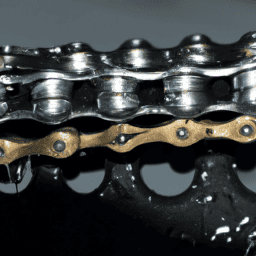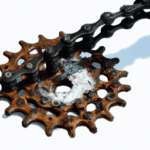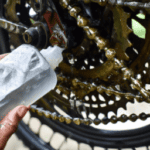As someone who is passionate about cycling, I recognize the critical role that appropriate upkeep plays in ensuring a seamless and effective journey. Lubricating the bicycle chain stands out as a vital part of bike maintenance. Ensuring your chain is adequately lubricated not only makes for a smoother ride but also diminishes the stress and damage on both the chain and the gears.
In this article, I will provide a step-by-step guide on how to oil a bicycle chain.
Before we dive into the process, it is important to note that there are different types of bicycle chain oils available in the market. It is essential to choose the right type of oil for your bicycle chain, depending on the weather conditions and the type of cycling you engage in.
With the right oil and the proper technique, you can keep your bike’s chain running smoothly for miles. So, let’s get started on how to oil a bicycle chain.
Key Takeaways
- Proper maintenance is key for a smooth and efficient ride, and oiling the bicycle chain is crucial for bike maintenance.
- Choosing the right type of bicycle chain oil is important depending on weather conditions and type of cycling.
- Supplies needed for oiling chain include a clean rag and suitable lubricant, and wet lubricants are ideal for wet and muddy conditions while dry lubricants are better for dry and dusty conditions.
- Applying high-quality chain oil after every 100-150 miles of riding or after every few rides in wet or muddy conditions reduces friction and wear on chain, prevents rust and corrosion, and provides a more enjoyable riding experience.
Gather the Necessary Supplies
Before you can start oiling your bicycle chain, you’ll need to gather all the necessary supplies. Firstly, you’ll need a clean rag to wipe down the chain and remove any dirt or debris that may have accumulated on it. This ensures that the lubricant can penetrate the chain links and provide maximum protection against wear and tear.
Next, you’ll need to choose a lubricant that’s suitable for your bike. There are different types of lubricants available, such as wet and dry lubricants. Wet lubricants are ideal for wet and muddy conditions, while dry lubricants are better suited for dry and dusty conditions. It’s important to choose the right type of lubricant to ensure that your chain stays well lubricated and protected.
Once you’ve gathered all the necessary supplies, you can move on to preparing your bike for oiling.
Prepare the Bike
First, make sure you are wearing appropriate clothing and have your hair tied back to avoid any accidents. Think of yourself as a chef preparing to cook a delicious meal – you want to make sure you have all the necessary ingredients and tools before you begin. Once you are properly dressed, position your bike on a clean surface where you can comfortably work on it. Before applying any oil, it’s important to remove excess dirt from the chain. I recommend using a degreaser and a rag to thoroughly clean the chain.
To prepare the bike for oiling, you will need the following supplies: a degreaser, a clean rag, and a bike stand (optional). Refer to the table below for a quick overview of the supplies and their purpose.
| Supplies | Purpose |
|---|---|
| Degreaser | Cleans the chain |
| Clean Rag | Wipes off excess dirt and degreaser |
| Bike Stand | Holds the bike in place for easy access to the chain |
With a clean surface and a degreased chain, you are now ready to apply the oil.
Apply the Oil
Now it’s time to give your trusty two-wheeler the TLC it deserves by giving it a fresh coat of lubrication, ensuring a smooth ride every time you hit the road.
To apply the oil, start by holding the oil bottle up to the chain and gently squeezing it to let the oil drip onto each section of the chain. It’s important to apply the oil evenly, making sure that all parts of the chain receive equal lubrication.
Be careful not to over-oil the chain, as this will attract dirt and debris, causing your chain to wear out more quickly. To avoid this, apply just enough oil to coat the chain, wiping off any excess with a clean rag.
Once you’ve finished applying the oil, rotate the pedals several times to ensure that the oil is spread evenly throughout the chain. With proper lubrication, your bike will be ready for your next adventure.
Make sure to check for proper lubrication before you hit the road.
Check for Proper Lubrication
Ensure your ride stays smooth by checking that your trusty steed has proper lubrication throughout. After applying the oil, it’s important to check for proper lubrication.
Signs of wear include a noisy chain and difficulty shifting gears. If you notice these signs, it’s time to reapply oil to the chain.
Choosing the right oil for your chain is also important. It’s best to use a lubricant specifically designed for bicycle chains. Avoid using motor oil or cooking oil, as they can attract dirt and grime which can cause more wear and tear on the chain.
Once you’ve applied the right oil, make sure to maintain regular oilings to keep your bicycle running smoothly.
Test Your Chain
Now that I’ve wiped off excess lubricant from my bicycle chain, it’s time to test it.
To do this, I’ll shift through all the gears to make sure the chain moves smoothly and quietly.
I’ll also check for any issues, such as skipping or grinding, which could indicate a problem with the chain or gears.
Shift Through the Gears
To shift through the gears, you’ll want to keep the chain lubricated and smooth. Did you know that a properly lubricated chain can make your bike ride up to 2.5 times more efficient? Imagine effortlessly gliding through the gears and conquering hills with ease. Proper gear usage and avoiding chain skipping are crucial in maintaining a smooth and efficient ride. When shifting gears, make sure to ease up on the pedals and shift smoothly. Avoid cross-chaining, which is when you use the largest chainring and the largest sprocket or the smallest chainring and the smallest sprocket. This puts unnecessary strain on the chain and can cause it to skip or even break.
The importance of chain cleanliness also has a significant impact on shifting performance. Dirt, grime, and debris can build up on the chain and clog the links, causing it to stick and not shift smoothly. Regularly cleaning your chain with a degreaser and a brush will help prevent this and keep your shifting performance at its best. In addition to cleaning, lubricating your chain with a bike-specific lubricant will ensure that it stays smooth and efficient. Remember to wipe off any excess lubricant after application to prevent attracting more dirt and debris. Before moving on to the next step, check for any issues with your shifting performance or chain tension.
Check for Any Issues
Check if there are any problems with your gear shifts and make sure your bike runs smoothly. Before oiling your bicycle chain, it’s important to inspect your bike thoroughly.
Take the time to check your gear shifts and ensure that they’re functioning properly. Shift through all the gears and make sure that they’re engaging smoothly and without any hesitation. If you notice any issues, such as difficulty shifting or skipping gears, it’s important to address these problems before oiling your chain.
Along with checking your gear shifts, it’s important to inspect your chain for any common problems. These include rust, build-up of dirt or debris, and wear and tear. Rust can cause your chain to become weak and brittle, making it more susceptible to breaking. Dirt and debris can cause your chain to become stiff and difficult to move, which can put unnecessary strain on your bike’s gears. Wear and tear can cause your chain to stretch and become loose, which can affect your bike’s overall performance.
By inspecting your chain and addressing any issues before oiling, you can help ensure that your bike runs smoothly and efficiently.
Maintain Regular Oilings
Don’t forget to keep up with regular applications of the appropriate lubricant to ensure a smooth ride. A properly lubricated bike chain will not only make your ride smoother, but it will also ensure that your bike lasts longer.
The importance of lubrication frequency cannot be stressed enough. It’s recommended to apply chain oil after every 100-150 miles of riding or after every few rides if you encounter wet or muddy conditions.
Using high-quality chain oil is crucial to maintaining the longevity of your bike chain. It not only reduces friction and wear on the chain, but it also prevents rust and corrosion from forming. The benefits of using high-quality chain oil are twofold: it’ll save you money in the long run by reducing the need for costly chain replacements, and it’ll provide a more enjoyable riding experience.
So, don’t forget to regularly oil your bike chain with a high-quality chain oil to ensure a smooth and long-lasting ride.
Frequently Asked Questions
How often should I oil my bicycle chain?
I oil my bicycle chain every 200 miles to ensure optimal performance and longevity. Regular chain maintenance provides benefits such as smoother shifts, reduced wear and tear, and increased efficiency. To tell when it’s time to oil your chain, check for rust or a dry, squeaky sound.
What type of oil should I use for my bicycle chain?
I prefer using synthetic oil for my bicycle chain because it provides superior lubrication and lasts longer. Wax-based lubricants, while environmentally friendly, may not offer as much protection. It’s important to weigh the benefits and drawbacks before choosing a lubricant.
Can I over-oil my bicycle chain?
Over oiling a bike chain can attract dirt and grime, reduce efficiency, and cause chain-skip. To prevent over-oiling, apply a small amount of high-quality lubricant and wipe off excess. To troubleshoot, clean the chain and reapply oil as needed.
Should I clean my bicycle chain before oiling it?
Of course not, why bother with all that extra effort? Just pour a whole bottle of oil on your dirty chain and call it a day. Who needs chain cleaning techniques or the benefits of using a chain cleaner before oiling?
Is it necessary to remove the chain from the bike to oil it?
No, it is not necessary to remove the chain from the bike to oil it. However, proper chain maintenance and lubrication techniques should be followed to ensure maximum effectiveness and longevity of the chain.
How often should I oil my bicycle chain?
I oil my bicycle chain every 100-200 miles to prevent wear and tear. However, I’ve found that using dry chain lubrication has benefits such as reducing dirt build-up. In wet or humid weather, I oil more frequently.
Can I use any type of lubricant on my bicycle chain?
Choosing the right lubricant for your bike chain is crucial. Using the wrong type can cause potential harm to your bike. Don’t make that mistake. Consult with a professional to find the perfect lubricant for your bike.
Is it okay to use too much lubricant on my bicycle chain?
Using too much lubricant on a bicycle chain can attract dirt and debris, leading to faster wear and tear. Proper application techniques involve applying a thin layer of lubricant and wiping off excess.
What should I do if my bicycle chain is rusty before oiling it?
If my bicycle chain is rusty, I first remove the rust with the best rust removers like naval jelly or white vinegar. After that, I lubricate the chain.
Can I use a degreaser to clean my bicycle chain before oiling it?
Yes, I can use a degreaser to clean my bicycle chain before oiling it. Pros include removing dirt and grime, while cons include potentially damaging the chain and removing necessary lubrication.
Conclusion
Well, folks, that’s all there is to it! You’ve successfully learned how to oil a bicycle chain. It’s a fairly simple process that can make a world of difference in the longevity of your bike’s chain and overall performance.
Remember to gather all the necessary supplies, prepare your bike, apply the oil, and check for proper lubrication. And don’t forget to maintain regular oilings to keep your chain in tip-top shape.
Now, we all know that a bike’s chain can become quite dry and creaky over time, causing a less than enjoyable ride. But fear not, with this simple process, you can ensure that your bike rides smoothly and quietly.
So, go ahead and give your bike some love by oiling its chain. Your bike (and your ears) will thank you for it!
















